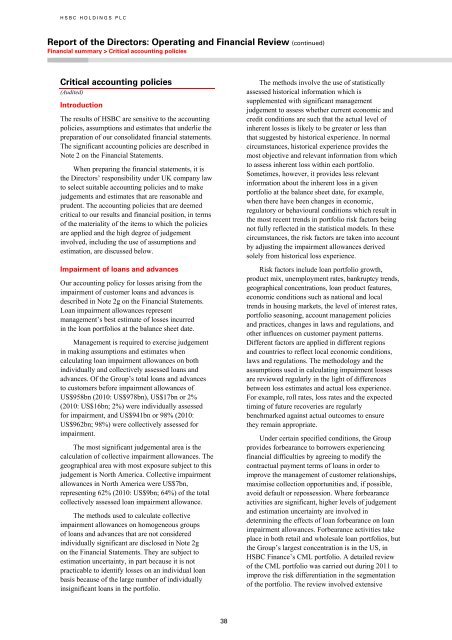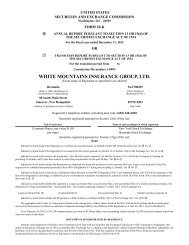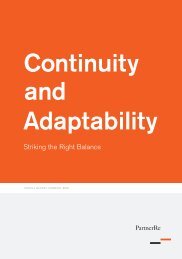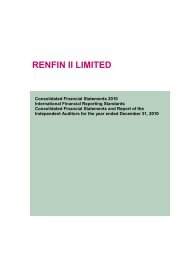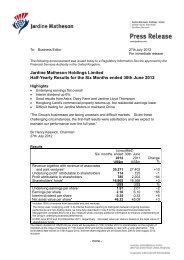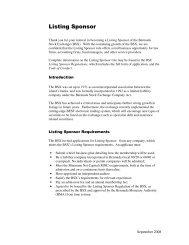Annual Report and Accounts 2011 - Bermuda Stock Exchange
Annual Report and Accounts 2011 - Bermuda Stock Exchange
Annual Report and Accounts 2011 - Bermuda Stock Exchange
You also want an ePaper? Increase the reach of your titles
YUMPU automatically turns print PDFs into web optimized ePapers that Google loves.
HSBC HOLDINGS PLC<br />
<strong>Report</strong> of the Directors: Operating <strong>and</strong> Financial Review (continued)<br />
Financial summary > Critical accounting policies<br />
Critical accounting policies<br />
(Audited)<br />
Introduction<br />
The results of HSBC are sensitive to the accounting<br />
policies, assumptions <strong>and</strong> estimates that underlie the<br />
preparation of our consolidated financial statements.<br />
The significant accounting policies are described in<br />
Note 2 on the Financial Statements.<br />
When preparing the financial statements, it is<br />
the Directors’ responsibility under UK company law<br />
to select suitable accounting policies <strong>and</strong> to make<br />
judgements <strong>and</strong> estimates that are reasonable <strong>and</strong><br />
prudent. The accounting policies that are deemed<br />
critical to our results <strong>and</strong> financial position, in terms<br />
of the materiality of the items to which the policies<br />
are applied <strong>and</strong> the high degree of judgement<br />
involved, including the use of assumptions <strong>and</strong><br />
estimation, are discussed below.<br />
Impairment of loans <strong>and</strong> advances<br />
Our accounting policy for losses arising from the<br />
impairment of customer loans <strong>and</strong> advances is<br />
described in Note 2g on the Financial Statements.<br />
Loan impairment allowances represent<br />
management’s best estimate of losses incurred<br />
in the loan portfolios at the balance sheet date.<br />
Management is required to exercise judgement<br />
in making assumptions <strong>and</strong> estimates when<br />
calculating loan impairment allowances on both<br />
individually <strong>and</strong> collectively assessed loans <strong>and</strong><br />
advances. Of the Group’s total loans <strong>and</strong> advances<br />
to customers before impairment allowances of<br />
US$958bn (2010: US$978bn), US$17bn or 2%<br />
(2010: US$16bn; 2%) were individually assessed<br />
for impairment, <strong>and</strong> US$941bn or 98% (2010:<br />
US$962bn; 98%) were collectively assessed for<br />
impairment.<br />
The most significant judgemental area is the<br />
calculation of collective impairment allowances. The<br />
geographical area with most exposure subject to this<br />
judgement is North America. Collective impairment<br />
allowances in North America were US$7bn,<br />
representing 62% (2010: US$9bn; 64%) of the total<br />
collectively assessed loan impairment allowance.<br />
The methods used to calculate collective<br />
impairment allowances on homogeneous groups<br />
of loans <strong>and</strong> advances that are not considered<br />
individually significant are disclosed in Note 2g<br />
on the Financial Statements. They are subject to<br />
estimation uncertainty, in part because it is not<br />
practicable to identify losses on an individual loan<br />
basis because of the large number of individually<br />
insignificant loans in the portfolio.<br />
The methods involve the use of statistically<br />
assessed historical information which is<br />
supplemented with significant management<br />
judgement to assess whether current economic <strong>and</strong><br />
credit conditions are such that the actual level of<br />
inherent losses is likely to be greater or less than<br />
that suggested by historical experience. In normal<br />
circumstances, historical experience provides the<br />
most objective <strong>and</strong> relevant information from which<br />
to assess inherent loss within each portfolio.<br />
Sometimes, however, it provides less relevant<br />
information about the inherent loss in a given<br />
portfolio at the balance sheet date, for example,<br />
when there have been changes in economic,<br />
regulatory or behavioural conditions which result in<br />
the most recent trends in portfolio risk factors being<br />
not fully reflected in the statistical models. In these<br />
circumstances, the risk factors are taken into account<br />
by adjusting the impairment allowances derived<br />
solely from historical loss experience.<br />
Risk factors include loan portfolio growth,<br />
product mix, unemployment rates, bankruptcy trends,<br />
geographical concentrations, loan product features,<br />
economic conditions such as national <strong>and</strong> local<br />
trends in housing markets, the level of interest rates,<br />
portfolio seasoning, account management policies<br />
<strong>and</strong> practices, changes in laws <strong>and</strong> regulations, <strong>and</strong><br />
other influences on customer payment patterns.<br />
Different factors are applied in different regions<br />
<strong>and</strong> countries to reflect local economic conditions,<br />
laws <strong>and</strong> regulations. The methodology <strong>and</strong> the<br />
assumptions used in calculating impairment losses<br />
are reviewed regularly in the light of differences<br />
between loss estimates <strong>and</strong> actual loss experience.<br />
For example, roll rates, loss rates <strong>and</strong> the expected<br />
timing of future recoveries are regularly<br />
benchmarked against actual outcomes to ensure<br />
they remain appropriate.<br />
Under certain specified conditions, the Group<br />
provides forbearance to borrowers experiencing<br />
financial difficulties by agreeing to modify the<br />
contractual payment terms of loans in order to<br />
improve the management of customer relationships,<br />
maximise collection opportunities <strong>and</strong>, if possible,<br />
avoid default or repossession. Where forbearance<br />
activities are significant, higher levels of judgement<br />
<strong>and</strong> estimation uncertainty are involved in<br />
determining the effects of loan forbearance on loan<br />
impairment allowances. Forbearance activities take<br />
place in both retail <strong>and</strong> wholesale loan portfolios, but<br />
the Group’s largest concentration is in the US, in<br />
HSBC Finance’s CML portfolio. A detailed review<br />
of the CML portfolio was carried out during <strong>2011</strong> to<br />
improve the risk differentiation in the segmentation<br />
of the portfolio. The review involved extensive<br />
38


